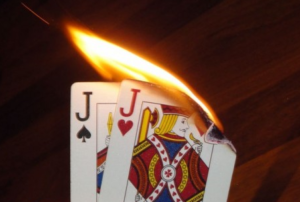 The WSOP is right around the corner, so today I would like to share with you a hand I played in a $1,500 buy-in event last year. With blinds of 100/200, I raised to 500 out of my 20,000 stack from early position with J-J. A good, tight, aggressive kid, who was down to 5,000 chips due to recently losing a big pot with Q-Q to A-K, called from middle position. A loose, splashy player with 20,000 called from the big blind.
The WSOP is right around the corner, so today I would like to share with you a hand I played in a $1,500 buy-in event last year. With blinds of 100/200, I raised to 500 out of my 20,000 stack from early position with J-J. A good, tight, aggressive kid, who was down to 5,000 chips due to recently losing a big pot with Q-Q to A-K, called from middle position. A loose, splashy player with 20,000 called from the big blind.
The flop came Td-5s-2h. The big blind checked and I bet 700 into the 1,600 pot.
I like this bet size because it allows both of my opponents to easily stick around with a wide range of hands that I crush. Notice that my bet size is significantly different than the sizing many recreational players use. Instead of making a bet that can easily be called by a wide range of junk, they bet huge, hoping to make their opponents fold their “drawing” hands. Notice that if the opponents fold hands like 5-4, they are correctly folding to the large bet. By making a smaller bet that can be reasonably called by inferior hands, I extract value and allow my opponents to make errors. Remember, you want to induce your opponents to play poorly.
Only the tight, aggressive kid called. The turn was the (Td-5s-2h)-8c. I bet 1,100 out of my opponent’s 3,775 stack into the 3,075 pot.
It is vitally important that you pay attention to the effective stack size when determining how much to bet. In this situation, I want to size my bet such that I can go all-in on the river for less than the size of the pot while at the same time not making my opponent feel “obviously committed” on the turn. If I instead bet 2,300 into the 3,075 pot, my opponent would only have 1,475 remaining in his stack going to the river. This would likely induce him to fold many hands that I crush on the turn, meaning I am not getting value. If I bet 600 into the 3,075 pot, my opponent would have 3,175 in his stack going to the river with a 4,275 pot. While that is a nice stack to pot ratio going to the river, my opponent’s turn call would be profitable with almost any two cards, even if he is drawing thin, due to his amazing pot odds. (If I bet 600 on the turn, he would only need to win 14% of the time to profitably call.)
My opponent called. The river was the (Td-5s-2h-8c)-9d. I decided to go all-in for my opponent’s entire 2,675 stack into the 5,275 pot, thinking he would call with many made hands that I beat. After about three minutes of thought, my opponent folded.
Looking back at this hand, I do not like my river bet. I lose to all slow played hands as well as stubborn 9-9 or 8-8. My opponent may not call an all-in with a hand like Q-T, thinking I must have a better hand to value bet on all three streets. It is also quite difficult for me to come up with many hands that I beat besides exactly A-T, K-T, Q-T, and J-T. While I do not love either of my options on the river, I think checking, hoping my opponent either turns a hand like A-Q or 7-7 into a bluff or value bets thinly with a hand like Q-T, is ideal.
 Thank you for taking the time to read this blog post. If you enjoyed it, please share it with your friends. If you want to continue working on your poker skills, be sure to sign up for your free 7-day trial to my interactive training site, PokerCoaching.com.
Thank you for taking the time to read this blog post. If you enjoyed it, please share it with your friends. If you want to continue working on your poker skills, be sure to sign up for your free 7-day trial to my interactive training site, PokerCoaching.com.
Be sure to check back next week for another educational blog post. Thanks for reading!

Is the concept that it’s worth the risk of them catching an A, K, Q for a pair because your JJ will pay off enough to make it worth keeping them in? Are odds better on that? I just feel like the A, K, Q seem to show up a lot.
Yep, and when those cards come, I can easily check and lose only a small amount. I am sure you can do some quick math to figure out how often an A, K, or Q comes. It “seeming” to come a lot is irrelevant.
hmm i too have noticed that the A K and Q seem to come out often.